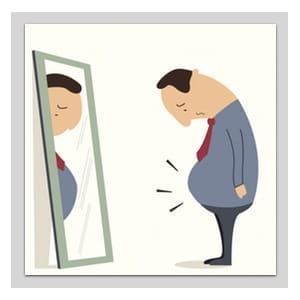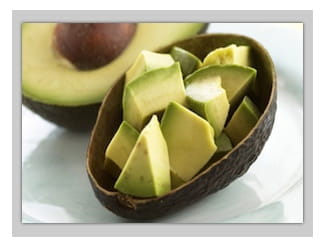Abdominal Fat Dangers
The difference between subcutaneous fat and the more deadly “visceral fat”… Plus the simple steps to REMOVE this fat permanently
 Although this picture depicts an overweight man, this article applies to dangerous types of fat inside the bodies of both men and women… and this discussion also applies even if you only have a slight amount of excess stomach fat.
Although this picture depicts an overweight man, this article applies to dangerous types of fat inside the bodies of both men and women… and this discussion also applies even if you only have a slight amount of excess stomach fat.
Did you know that the vast majority of people in this day and age have excess abdominal fat? It’s true — as much as 70% of the population in some “westernized” countries such as the US and Australia are now considered either overweight or obese. The first thing that most people think of is that their extra abdominal fat is simply ugly, is covering up their abs from being visible, and makes them self conscious about showing off their body.
However, what most people don’t realize is that excess abdominal fat in particular, is not only ugly, but is also a dangerous risk factor to your health. Scientific research has clearly determined that although it is unhealthy in general to have excess body fat throughout your body, it is also particularly dangerous to have excess abdominal fat.
There are two types of fat that you have in your abdominal area. The first type that covers up your abs from being visible is called subcutaneous fat and lies directly beneath the skin and on top of the abdominal muscles.
The second type of fat that you have in your abdominal area is called visceral fat, and that lies deeper in the abdomen beneath your muscle and surrounding your organs. Visceral fat also plays a role in giving certain men that “beer belly” appearance where their abdomen protrudes excessively but at the same time, also feels sort of hard if you push on it.
Both subcutaneous fat and visceral fat in the abdominal area are serious health risk factors, but science has shown that having excessive visceral fat is even more dangerous than subcutaneous fat. Both types of fat greatly increase your risk of developing heart disease, diabetes, high blood pressure, stroke, sleep apnea, various forms of cancer, and other degenerative diseases.
Part of the reason visceral fat is particularly dangerous is that studies show that it releases more inflammatory molecules into your system on a consistent basis.
One of the major reasons that some people accumulate more visceral fat than others can be from a high carbohydrate diet that leads to insulin resistance over time (years of bombarding your system with too much sugars and starches for your pancreas to properly handle the constant excess blood sugar) … and studies show that high fructose intake particularly from high-fructose corn syrup can be a major contributor to excess visceral fat.
So what gets rid of extra abdominal fat, including visceral fat?
Both your food intake as well as your training program are important if you are to get this right and the good news is that I’ve spent over a decade researching this topic, analyzing the science, and applying it “in the trenches” with myself as well as thousands of my clients from all over the world to see what works to really stimulate abdominal fat loss.
I’ve actually even seen a particular study that divided thousands of participants into a diet-only group and an exercise & diet combined group. While both groups in this study made good progress, the diet-only group lost significantly LESS abdominal fat than the diet & exercise combined group.
From my research, two of the most important aspects to getting rid of visceral fat are:
1. The use of high intensity forms of exercise and full-body resistance training. Low intensity cardio exercise simply isn’t as effective for removing visceral fat in particular. High intensity exercise such as interval training, sprints (bike sprints or running sprints), AND full-body weight training are very effective at helping to improve your body’s ability to manage glucose and increases insulin sensitivity, a crucial step in removing visceral fat.
 These types of high intensity exercise routines are also very effective at increasing your fat-burning hormones and creating a hormonal environment conducive to burning off abdominal fat, including visceral fat.
These types of high intensity exercise routines are also very effective at increasing your fat-burning hormones and creating a hormonal environment conducive to burning off abdominal fat, including visceral fat.
2. In addition, it’s vitally important to get blood sugar under control to help restore insulin sensitivity through the right nutrition. This means greatly reducing sugars and refined starches in your diet (including fully eliminating any use of harmful high fructose corn syrup!), and focusing more of your diet on healthy fats (such as avocados, nuts, seeds, coconut fat, olive oil, grass-fed butter, free-range eggs, fatty fish and fish oils, etc), as well as increasing protein and fiber intake. The standard diet recommended by the government, which contains an unnaturally high grain intake is NOT conducive to controlling blood sugar and reducing visceral fat!
Reducing grain-based foods in your diet and getting more of your carbs from veggies and high fiber fruits such as berries can go a long way to helping to solve this problem.
Abdominal Fat Dangers Read More »

 Useful for allergy season. It has been suggested that the combination of lemon and salt, specifically mixed into warm water, acts as a natural antihistamine for allergies. It may be the perfect alternative to those pink pills that leave you feeling drowsy.
Useful for allergy season. It has been suggested that the combination of lemon and salt, specifically mixed into warm water, acts as a natural antihistamine for allergies. It may be the perfect alternative to those pink pills that leave you feeling drowsy.


















